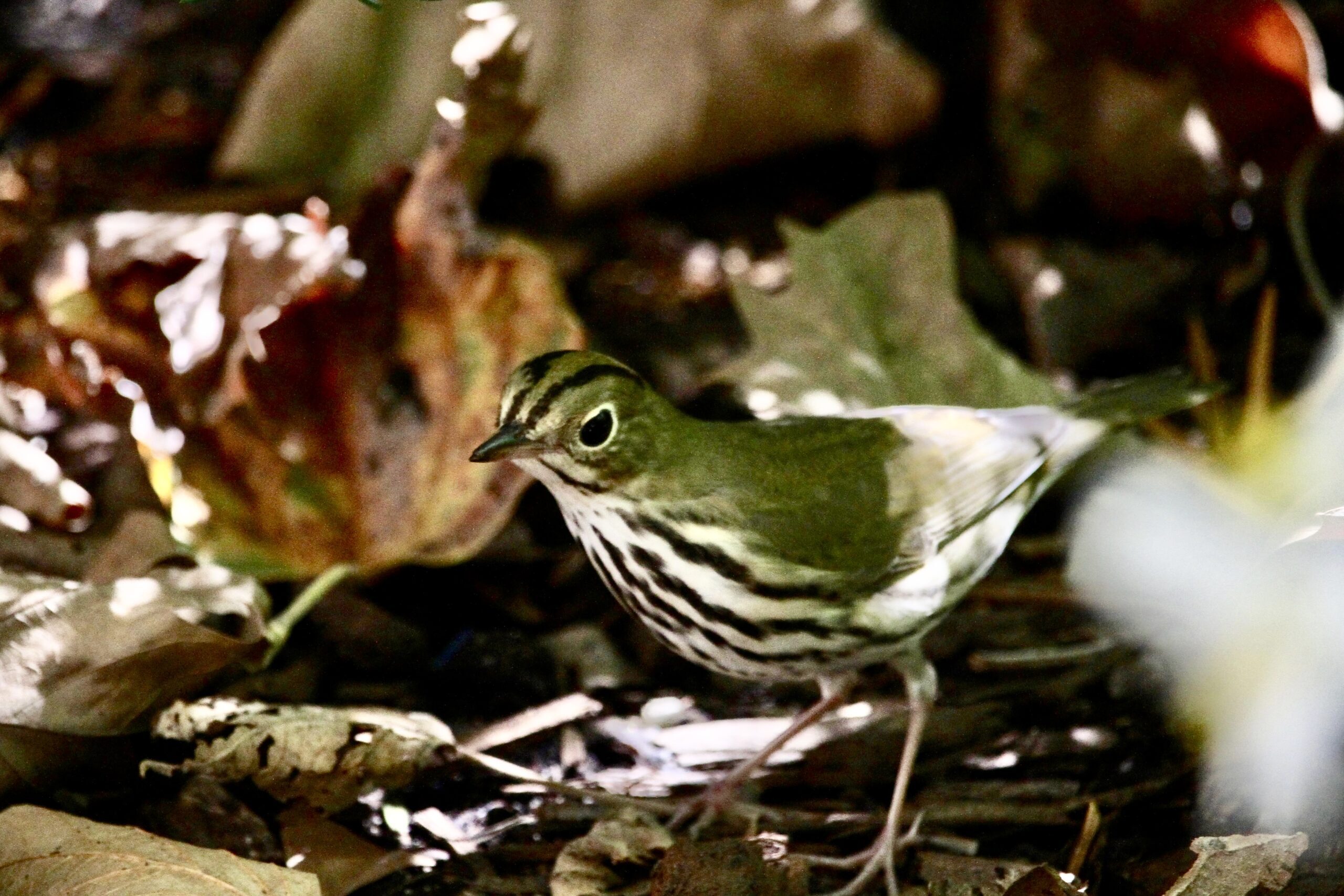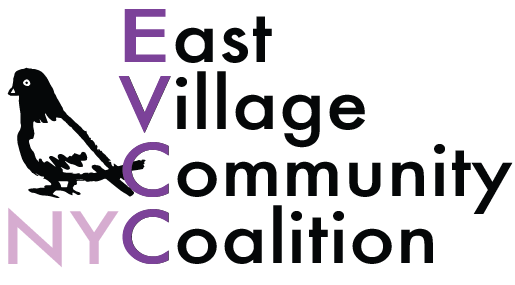Migrating birds arrive from afar to join their year-round counterparts in Tompkins each spring
Story and photos by Loyan Beausoleil
Spring is when birds drop into Tompkins Square Park for a good meal and a deserved rest. Most will already have traveled thousands of miles from Central and South America, and soon they will head on to their breeding grounds farther North. Tompkins gives them a chance to refuel.
Peak spring migration in New York is typically the first two weeks of May. This is the best time of year to go to Tompkins to look for migratory birds—and the best times of day are early morning or evening. Many migrate at night, and drop into the park right as the sun is coming up. Hungry after a full night of flying, they will forage for food immediately. They’ll then get busy again before sundown, filling up before another night of migration! The middle of the day is nap time.
Tompkins is noted for its mature trees, including many oaks and American elms, that benefit all park goers—human, insect, mammal, and avian. In April and May, brightly colored warblers forage in their canopies. Look for movement and flashes of color, and you may see Northern Parulas, Yellow-rumped Warblers, Black-throated Blue Warblers, American Redstarts or Black-throated Green Warblers as they search for insects that are drawn to the small tree flowers. Warblers are often high up, so a pair of binoculars is helpful, although on wet days they tend to forage on lower branches where they are protected from rain.
The ground is also an excellent place to see birds. Tompkins provides lawns, leaf biomass, native plantings and low shrubs where birds find food, shelter, and safety. Look for birds such as Eastern Towhee, Ovenbirds, Palm Warblers, and various sparrow species who forage in protected areas on the ground. These birds use lawns and other areas that feel safe to them. Look in areas of the park that are free of dogs, which birds perceive as being predatory.
Speaking of sparrows, if you’re looking for migratory sparrows you have your work cut out! Sparrows are some of the most subtle beauties of the bird world, and Tompkins can host up to 11 different native sparrow species during Spring migration!
Most people notice only the introduced House Sparrow, which is in the park year-round and competes aggressively with migratory species. Later in the year, you may see White-throated Sparrows, common in Tompkins from October through May. They have a white throat and striking head pattern, which may be tan-striped or black and white-striped. Look for a yellow patch near the eye. Other migratory sparrows can be more challenging. Look for subtle differences in size, color, pattern, and streaking. You may spot a tiny sparrow with a clean gray chest and gray face, and a rusty red cap. This is surely a Chipping Sparrow, which comes through the park each Spring in small flocks. They love safe, dog free, open lawns.
Most sparrows are a combination of brown, white and gray, although Dark-eyed Juncos, which are also sparrows, are lacking brown. They look like they are dressed up to go to a formal event, in a tuxedo of charcoal gray with white undersides, and they have a cute pink bill.
Some of the birds you see in Tompkins Square Park are non-migratory or short distance migrators. They are around all year. In spring local birds are pairing up and looking for a good place to nest. Birds like Blue Jays, Downy Woodpeckers, Northern Cardinals, and American Robins can be seen year-round in Tompkins. They are more vocal in the Spring as they try to attract a mate, maintain territory, and protect food resources. Blue Jays in particular are loud and raucous as they call out the presence of Raptors, such as Red-tailed Hawks and Cooper’s Hawks. Blue Jays will even copy the call of a Red-tailed Hawk to try to scare off other avian and mammal competitors.
Red-tailed Hawks are also in Tompkins Square Park year-round and a pair of these majestic birds have called the park home for over 13 years. One much-loved Red-tailed Hawk—named “Christo”—maintained Tompkins Square Park as his territory for most of this time. Sadly, he disappeared in February 2025. No one is sure what happened to him, but a new young male has swooped in to take over his duties.
Red-tailed Hawks nest in the park and play an important role, as they help to control rat, squirrel, and pigeon populations. In June people come from all over New York City to the park to see the Red-tailed Hawk youngsters who play together with sticks in one of the park’s safe, enclosed areas. Young hawks are especially vulnerable at this time, when they are learning to fly, and Urban Rangers and NYC Parks Department staff work to assure that fenced areas are locked and closed so that the young hawks have a chance to learn and grow. You can find more information about the Red-tailed Hawks of Tompkins Square Park here.
Anyone can look or listen for birds in Tompkins Square Park. All you need is patience and curiosity, although a pair of binoculars helps, especially if you’re looking for small birds. Look for movement. Even if you can’t identify a specific bird you can tell more generally what it might be. Small, colorful, active birds foraging in tree leaves are likely warblers. You may see a larger, mostly black and white bird, maybe with some red, moving along a tree branch. This is likely a kind of woodpecker. If you see small brown or gray birds, foraging at tree trunks and exploring crevices in bark, you’ve just found a Brown Creeper or White-breasted Nuthatch! When finding birds look at shape, size, color, pattern, and behavior to help determine what you’re seeing. You can use the American Robin as a standard asking “Is it larger or smaller than a robin? Is the beak shaped like a robin’s or is it different?” and then work from there to try to figure out what you’re seeing.
Now to the sobering part, the 2025 State of the Birds Report…one third of U.S. bird species are in trouble, including many common species that spend all or part of the year in New York City. Luckily anyone can easily do something to help our feathered friends.
If you live in NYC, one of the most important things you can do is try to limit window collisions, the leading cause of bird death in many urban environments. Birds see the sky or trees reflected in windows, and think they can fly on, similar to what people do when they walk into a clean glass door. By turning out unnecessary lights at night, and putting decals on windows to make the glass visible to birds, everyone can help lessen the numbers killed by windows.
Urban birds depend on small, limited green spaces like Tompkins. Keep out of park areas closed off or fenced, and allow migrating birds to forage and rest. Pet owners can talk to other pet owners about keeping cats indoors and dogs on leashes. Finally, feeding wildlife such as squirrels and pigeons leads to an overabundance. Most people don’t realize that the Eastern Gray Squirrel is omnivorous and a nest predator, which means it eats many things including bird eggs and baby birds. Anyone who has watched the Red-tailed Hawks in Tompkins Square Park has seen how ferociously Christo would protect his nest from squirrels.
Avoid putting out bird seed or bread. It attracts mainly pigeons and rats, which in turn can mean more rat poison, which in turn kills many raptors who might eat a rat that has ingested poison. By not feeding wildlife you help protect raptors, which are our cities natural method of pest control.
As you spend more time looking at birds you will get better at noticing those that seem a little different. A field guide, such as David Sibley’s “Guide to Birds of Eastern North America” is great. Apps such as “Merlin” can help you identify birds by sight and sound, and let you keep a list of the birds you see. “Birdcast” is an amazing tool that can be used during migration to predict when and where migratory birds are on the move. Finally, there are many local environmental groups that offer free bird outings. Everyone is welcome, no experience necessary! Check out the Lower East Side Ecology Center, Feminist Bird Club, Local Nature Lab, or NYC Bird Alliance to find a bird outing near you!
Happy Spring and happy birding!
Loyan Beausoleil is a formal educator who loves sharing her love of birds with others. She is also a local bird guide. Loyan has birded Tompkins Square Park for over 20 years.


